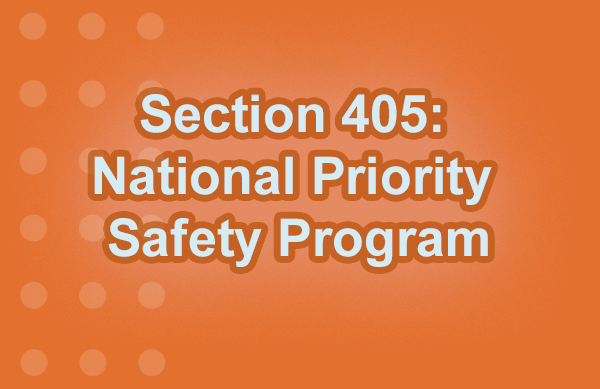Section 405: National Priority Safety Program


Section 405 is the National Priority Safety Program, which provides grant funding to address selected national priorities for reducing highway deaths and injuries.


Section 405 is the National Priority Safety Program, which provides grant funding to address selected national priorities for reducing highway deaths and injuries.
Under the Infrastructure Investment and Jobs Act (IIJA), which was enacted in November 2021, Section 405 is the National Priority Safety Program, which provides grant funding to address selected national priorities for reducing highway deaths and injuries. Previously authorized under MAP-21 and the FAST Act, the IIJA made a number of substantive changes to many of the grants, removed the Graduated Driver Licensing grant and added two new grants: Preventing Roadside Deaths and Driver and Officer Safety Education.
All are administered by the National Highway Traffic Safety Administration (NHTSA) at the federal level and the State Highway Safety Offices (SHSOs) at the state level.
Each program is authorized as a separate section or tier within Section 405, and each has its own eligibility criteria. States must satisfy the eligibility criteria of each tier in order to receive funding for that tier. States must submit their Section 405 applications on August 1 as part of the annual grant application process.
13% of Section 405 funds are earmarked for occupant protection incentive grants. States have to provide a 20% matching share. There are two types of grants: high belt use (90%+) and low belt use (below 90%). High belt use states must have an occupant protection plan, participate in national mobilizations, have an active network of child restraint inspection stations and maintain a sufficient number of Child Passenger Safety (CPS) technicians. Low belt use states have to satisfy these criteria plus three out of six more. High belt use states now may use up to 100% of their funds for any purpose under Section 402. However, all states must use 10% of funding to implement programs to provide child passenger safety programs among low-income and underserved populations.
14.5% of Section 405 funds are earmarked for traffic records incentive grants. States have to provide a 20% matching share. Eligible states must have a Traffic Records Coordinating Committee, a designated traffic records coordinator and a traffic records strategic plan. States also must show quantifiable progress in improving their traffic records systems according to six specific measures. States may use grant funds to improve core traffic safety databases by collecting key data, purchasing necessary equipment, improving compatibility and interoperability, traffic data research and training, and adoption of the Model Minimum Uniform Crash Criteria (MMUCC).
53% of Section 405 funds are earmarked for impaired driving incentive grants to reduce the risk of driving under the influence of alcohol, drugs or a combination of the two. States have to provide a 20% matching share. All states receive funds under this tier. They are divided into low-, medium-, and high-range states based on the most recent three years of Fatality Analysis Reporting System (FARS) data. Low-range states do not have to satisfy specific eligibility requirements. The requirements increase for the other two types of states. Low-range states have more flexibility in the use of funds than medium- or high-range states and may use up to 50% of the funds for any Section 402 purpose, in addition to qualifying by having an interlock program. The IIJA clarified the authorization to use grant funds for a range of impaired driving testing, training and technologies.
3% of this funding is earmarked for states with a compliant 24/7 sobriety program. The state must have a law that requires all individuals convicted of driving while intoxicated to receive restricted driving privileges for at least 30 days, and must have a law or program that authorizes a local or statewide 24/7 sobriety program.
12% of this tier is earmarked for ignition interlock incentive funds. States are eligible for grants if they have an all-offender ignition interlock law, a specific requirement for interlock use after conviction, or laws requiring interlock use for test refusal and compliance-based removal requirements. The law imposes certain limited exceptions.
Eligible states can use these funds for any purpose under 402. States can qualify with both provisions and receive a total of 15% of available funding.
8.5% of Section 405 funds are earmarked for distracted driving incentive grants. States that include distracted driving awareness in their driver's license examination are eligible for 50% of funding. States that enact either a prohibition on texting, a prohibition on handheld cell phone use or ban of the use of all electronic devices for all drivers aged 18 and younger, are eligible for the other 50%. However, states with secondary enforcement laws would only receive half of the funding. A state that enacts and enforces a law that prohibits a driver from viewing a personal wireless communications device is eligible for 25% of funding.
Eligible states can use 50% of the funds for Section 402 purposes and 50% for distracted driving purposes. States with distracted driving data that conforms to the most recent MMUCC to use 75% of the funds for Section 402 purposes. $5 million of these funds are earmarked for a national media campaign on distracted driving.
1.5% of Section 405 funds are earmarked for motorcyclist safety incentive grants. A state must satisfy two out of seven eligibility criteria to receive funds, and the use of funds is limited to only certain motorcycle training and awareness programs. States with the lowest 25% of motorcycle deaths per 10,000 registrations based on the most recent calendar year for which final FARS data are available are allowed to use 50% of their grant funds for any Section 402 purpose.
7% of Section 405 funds are earmarked for nonmotorized safety incentive grants. States would have to provide a 20% matching share. States are eligible if the annual combined non-motorized fatalities in the state exceed 15% of the total annual crash fatalities in the state using the most recently available final data from NHTSA’s FARS. The IIJA provides that eligible states may use grant funds for training law enforcement, enforcement mobilizations, public education and awareness programs, and collecting traffic safety data.
1% of Section 405 funds are earmarked for incentive grants to prevent roadside deaths. States must provide a 20% matching share. A state would be eligible for this grant if it submits a plan describing how they would use funds. States may use grant funds for purchasing e-digital alerting technology, educating the public about roadside safety, law enforcement and traffic safety data collection.
1.5% of Section 405 funds are earmarked for driver and officer safety education incentive grants. States must provide a 20% matching share. A state would be eligible for this grant if it either enacts a qualifying law or adopts a program, or if the state demonstrates that it is taking meaningful steps towards such an effort. States may use grant funds to implement programs to train drivers and police officers on the safe conduct of traffic stops. A state that is taking meaningful steps toward such and effort may only receive 50% of funding.